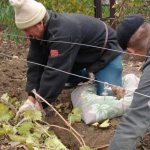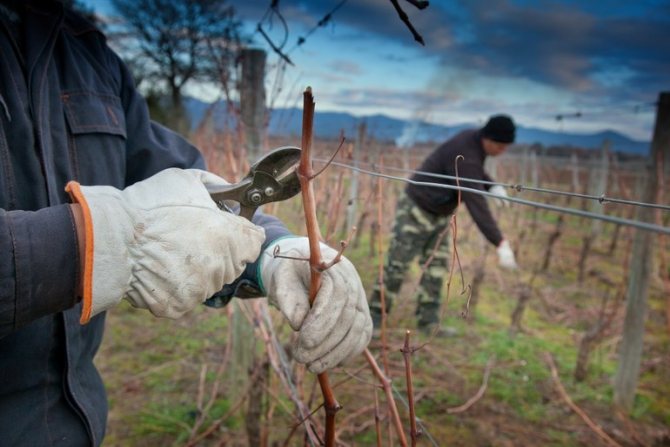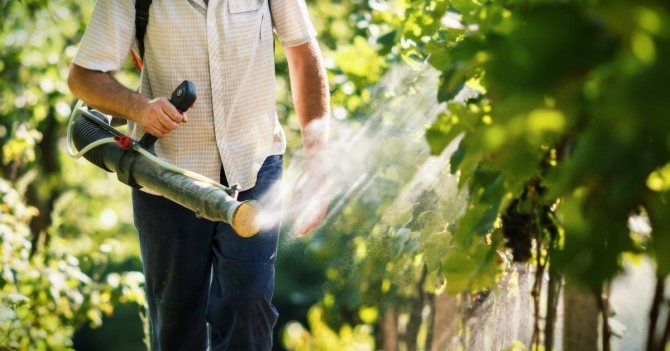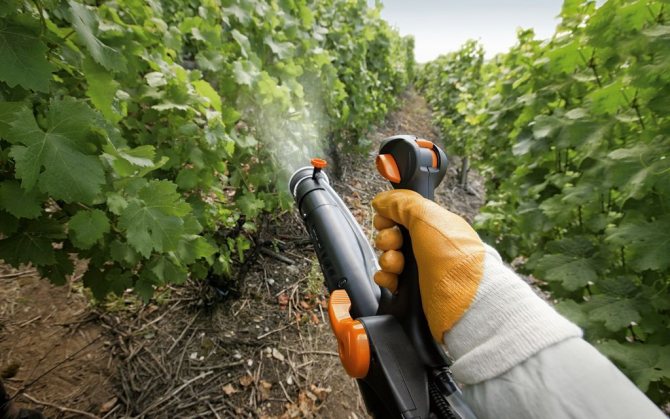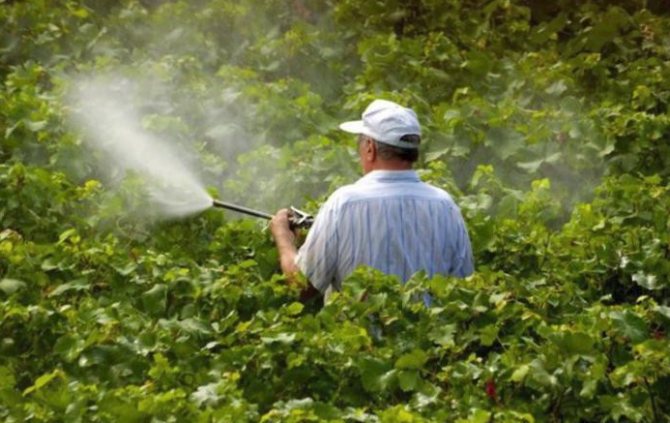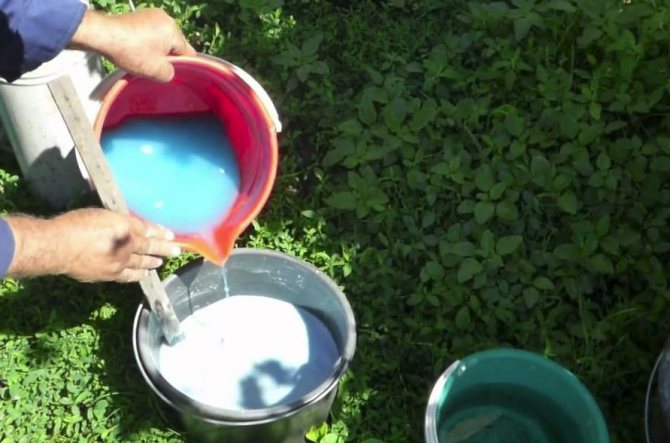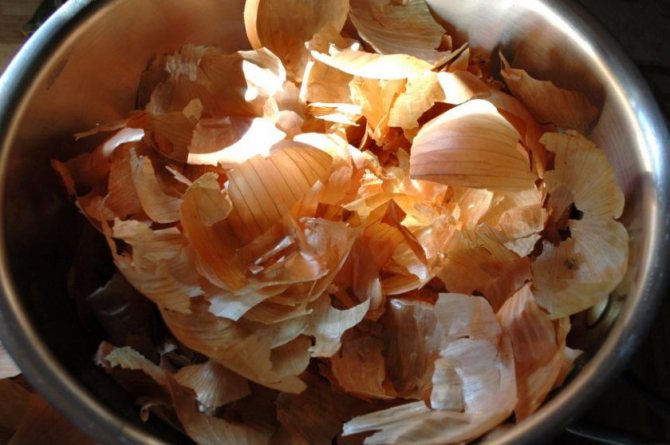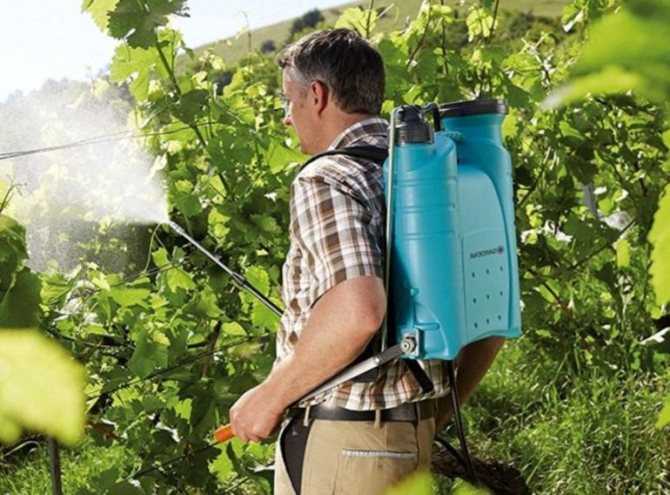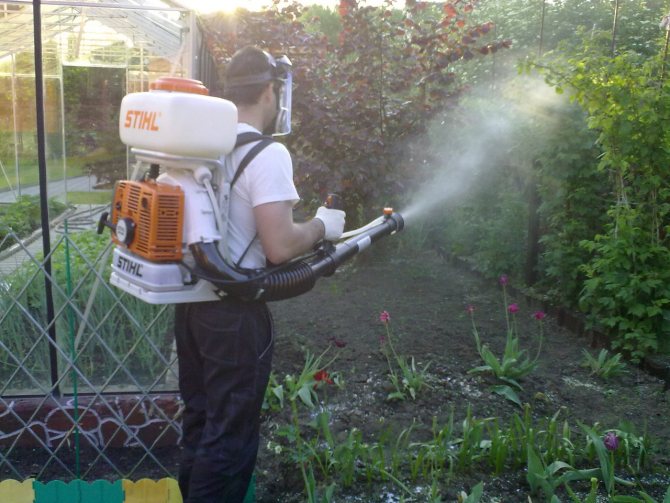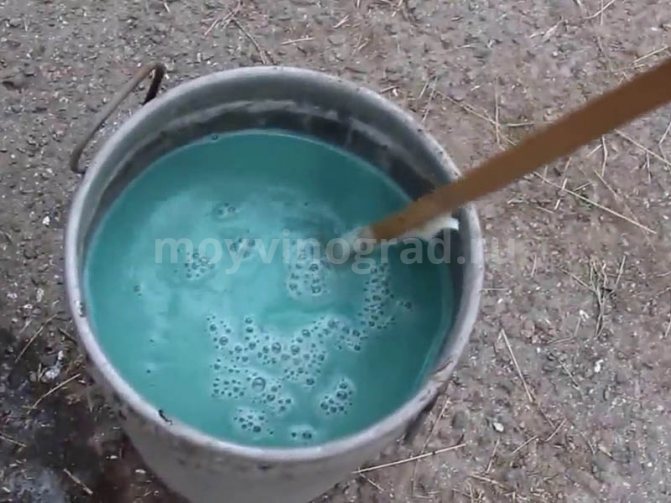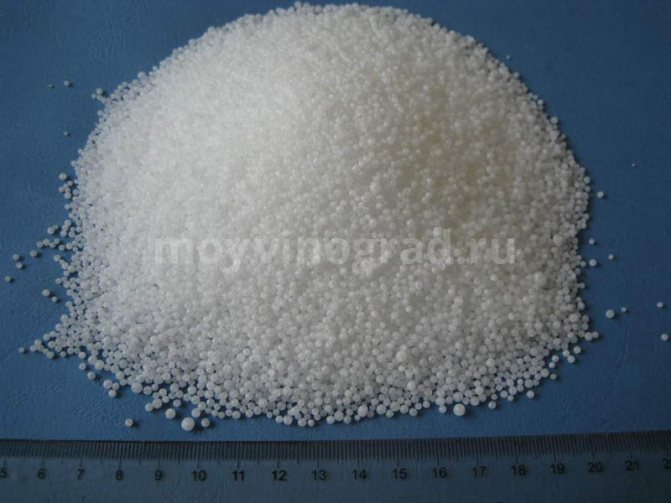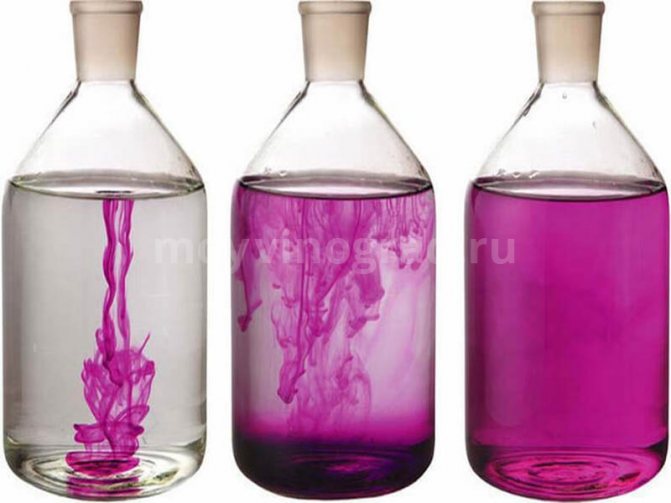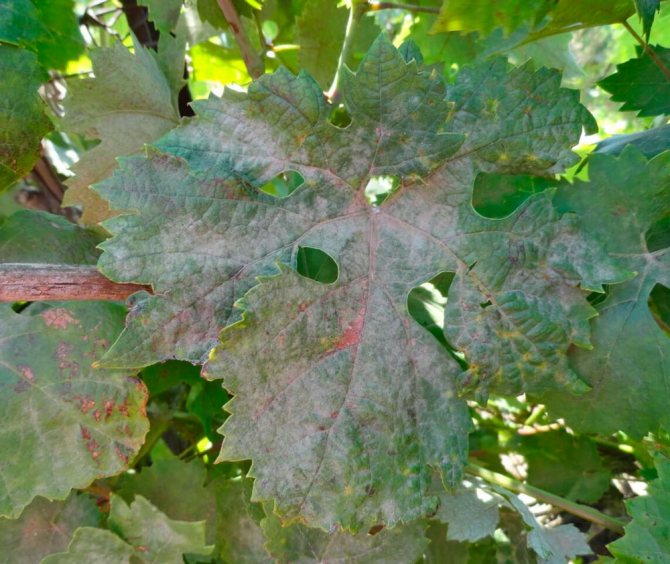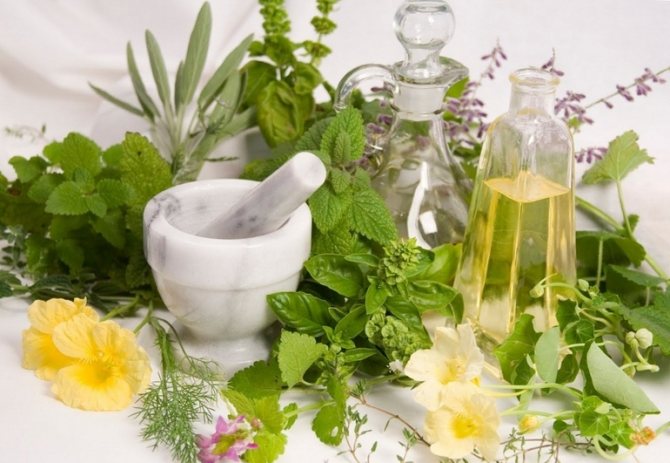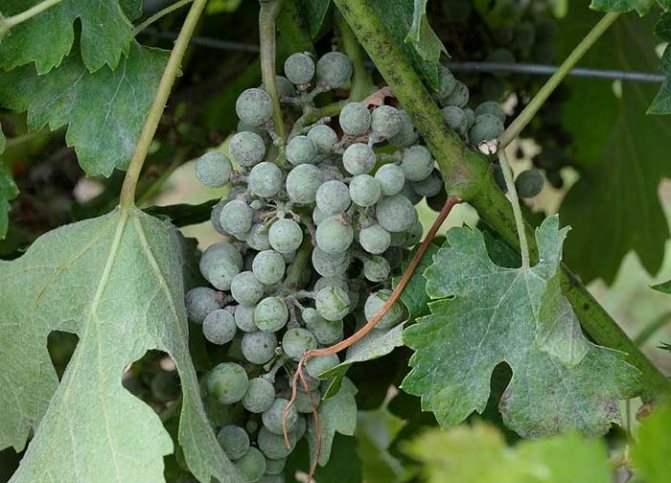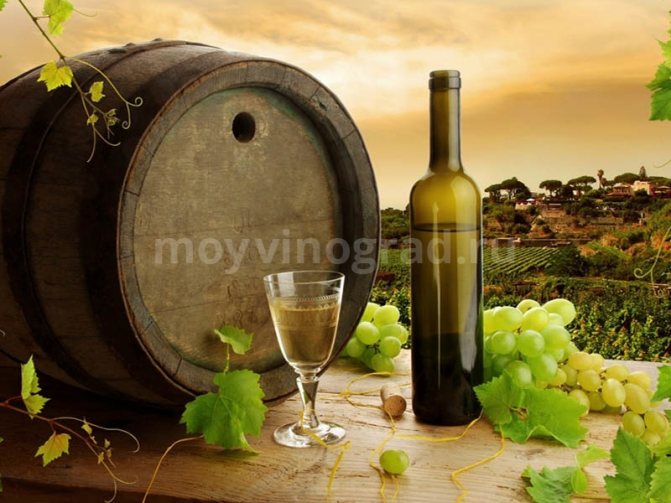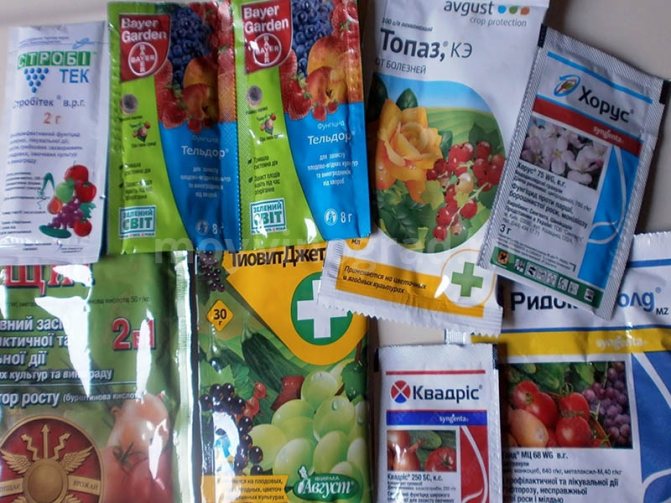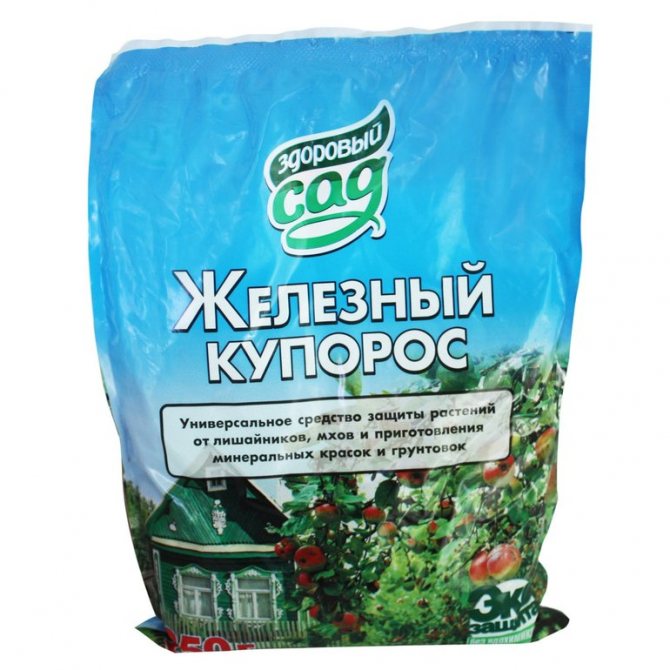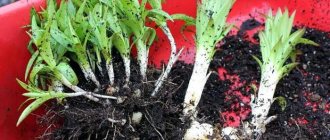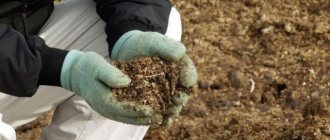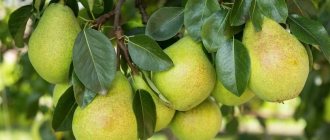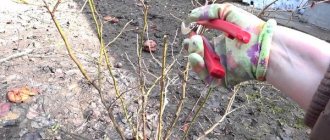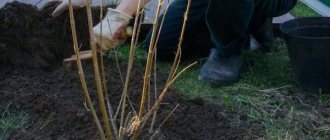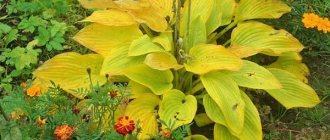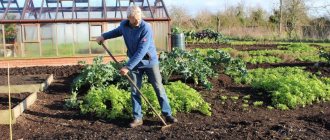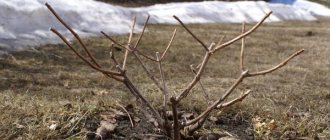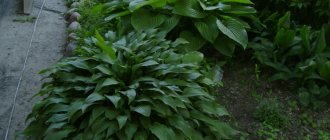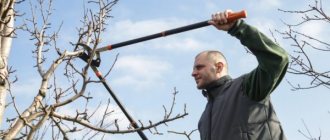Grape bushes for the entire growing season are often attacked by pests and various diseases. As a result, the yield decreases, the appearance and quality of the berries deteriorate. In addition to the fruit, roots, vines, leaves, buds and flowers are affected. Damaged plants begin to stagnate and, in the worst case, may even die. To grow a strong vine and get a good harvest, it is necessary to carry out protective treatment of the bushes from pests and diseases. This is especially important in the autumn, before sheltering the plant for the winter.
Rules for preparing a vineyard for winter
The processing of grape bushes to the shelter consists of several stages. The main activities include sanitary and preventive work and feeding.

Pruning
Autumn pruning of grapes is needed for the formation of a bush, the correct ratio of the ground and underground parts, and the removal of diseased shoots.
Pros of pruning in the fall:
- reduction of the crown for the convenience of shelter;
- stimulation of early bud opening;
- fast healing of wounds.
The main disadvantage of pruning is the high probability of freezing and brittleness of the top of the shortened shoot, but only if the procedure was carried out in late autumn on the eve of frost.
The best time to remove excess shoots on grapes is after the first frost, when the vine matures and the sap flow slows down. Active yellowing and falling foliage indicate the preparation of the plant for the rest period.
Important! Pruning too early will prevent young shoots from ripening, they will dry out or their buds will form late and give a meager harvest. They are also more prone to infections.
The bushes planted this year are not cut off, but only the leaves that have not fallen are removed.
Watering
If in the autumn after harvesting there is no rain or they are insignificant, then water-charging irrigation is carried out. He will provide the vines with water until the next summer and in times of drought. The soil saturated with water does not crack from frost, protects the roots from damage.
The irrigation period for mid-season varieties is mid-October-early November. Late varieties stop watering 30 days before harvest.
Sandy soils require less water but dry out faster. Clayey ones are irrigated less often, but more abundantly, taking into account the depth of groundwater.
Water the plants in the evening, in the pre-prepared basal holes, if there are no irrigation pipes. The water should flow out slowly, without falling on the foliage and stems. The depth of soaking is within 1-1.5 m. In the morning, the dry crust on the ground is loosened, the grooves are sprinkled with earth.
If the shelter of the bushes for the winter is not planned, irrigation is carried out after the foliage has fallen. In the opposite situation, already warmed plants are watered.
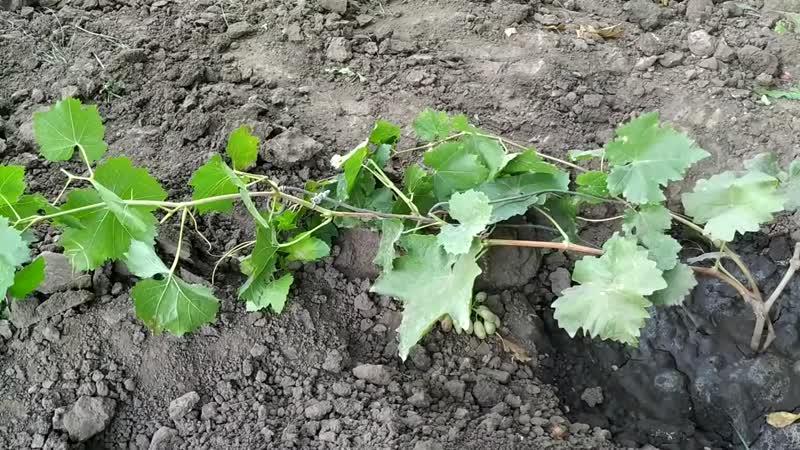

Top dressing
By the time the harvest ripens, grapes deplete their nutrient reserves. Autumn feeding with fertilizers based on potassium, phosphorus and trace elements will provide preparation for wintering. Adequate nutrient levels will restore strength for the future growing season and strengthen flower buds.
Treatment against diseases and pests
Autumn destruction of wintering species of pests and pathogens will preserve the health of the bush until spring and during the growing season.Treatment and prophylactic treatment is carried out before the shelter for the winter. Reducing the number of parasites and pathogens by digging the land around the vine bushes.
It is interesting:
Proven ways to keep grapes for the winter at home.
Step-by-step instructions for grafting grapes in the fall.
Shelter
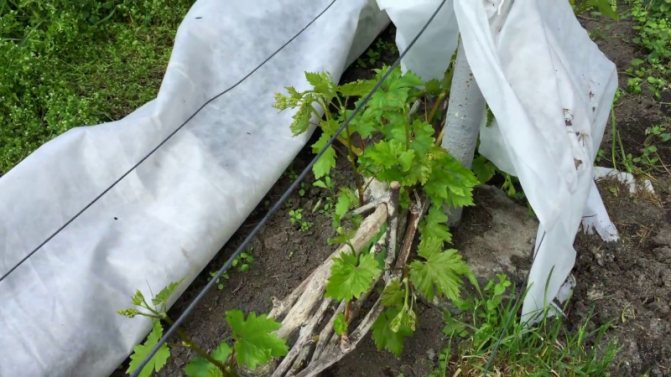

Protecting the grapes from frost is a must. The most vulnerable is the root system, it is insulated especially carefully. If the soil under an unprotected bush freezes to -5 ° C, the risk of plant death will increase significantly. Frostbite on the ground parts of the bush will reduce the quality and quantity of future grapes.
However, the first autumn frosts must be transferred uncovered by the grapes - this will have a positive effect on the frost resistance of the plant. Insulation is carried out at stable negative temperatures: 1-5 ° C of frost in the daytime, up to 7 ° C at night.
The most popular grape shelters are:
- pine or spruce spruce branches;
- straw;
- land;
- roofing material, film, non-woven material.
Fight disease
After the last berries have been removed from the bushes, it is necessary to conduct a thorough examination of the vine and foliage for pest infestation. Autumn processing of grapes from diseases is a guarantee that next year it will bear fruit well. After all, the main thing is to notice the infection in time and prevent the spread of the infection.
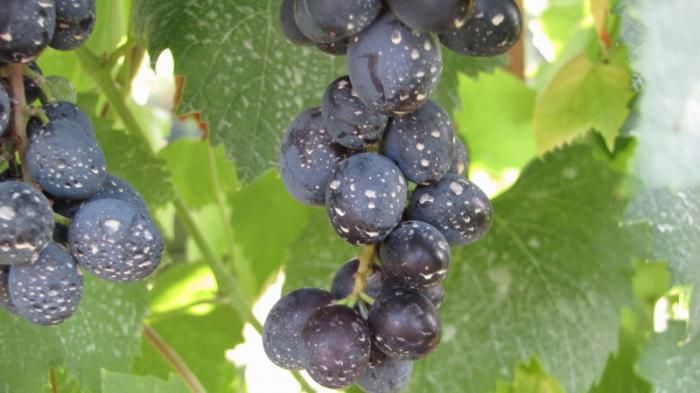

Due to the fact that the harvest is harvested, chemical agents can also be used as drugs against diseases and pests. So how to spray grapes in the fall?
In case of mildew infection (yellow or dirty-gray oily spots can be found on the leaves), the plant must be treated with special preparations such as "Amistar", "Efal", "Kartotsid", "Strobi" and others.
Oidium is the second most common grape disease. The unpleasant smell of rotten fish is a sign of this disease. How to process the grapes in this case? Spraying with colloidal sulfur is recommended (5 grams of the substance is taken for 4 liters of water). A solution of potassium permanganate is also suitable (for 10 liters of water - 5-7 grams of the drug). The drugs "Fundazol", "Falcon" and others will also help.
How to feed the vine
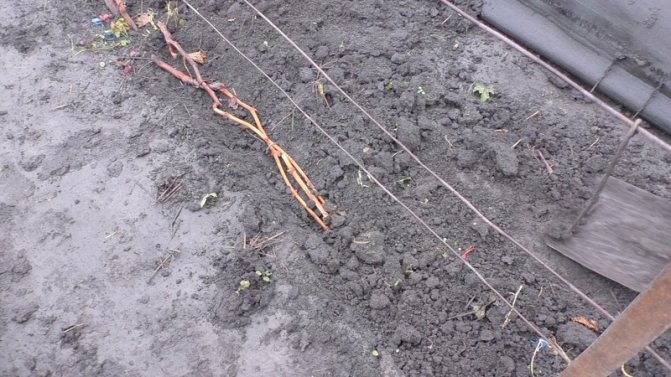

Autumn feeding begins from the third year of the life of the vines. The main macronutrients are phosphorus and potassium. For immunity, trace elements zinc, copper, magnesium must be included in the fertilizer.
An example of a complex mineral mixture for 10 liters of water:
- 20-25 g superphosphate;
- 25 g of potassium sulfate or 10 g of potassium salt;
- 1 g of boric acid, 1-2 g of zinc sulfate.
Dissolve the granules thoroughly in 1 liter of warm water, then pour the mother liquor into the rest of the water. The resulting solution is poured over 1 sq. m vineyard.
Dry application of mineral fertilizers is possible. The mixture is sprinkled on the near-trunk area and watering or deep digging is carried out.
Reference. Not the most depleted soil can be fed with wood ash at the rate of 300 g for each bush. It contains a lot of potassium, trace elements, neutralizes soil acidity and repels harmful insects. Ash is brought in dry during autumn digging or a weekly infusion is made in 10 liters of water.
It is allowed to introduce organic materials that improve air permeability, microbiological composition of the soil, make its structure looser. Suitable in this capacity:
- Rotted manure diluted in water in a ratio of 1: 4. For 1 sq. m of land, 8-10 liters of such a solution is enough.
- Bird droppings. For 10 days, it is soaked in water, in a ratio of 1: 4, and placed in a warm place. Before applying to the ground, it is additionally diluted with water to a ratio of 1:10.
- Well rotted compost. It is poured in a layer of 5 cm under the grape bush and sprinkled with soil.
Features of processing grapes with copper and iron sulfate
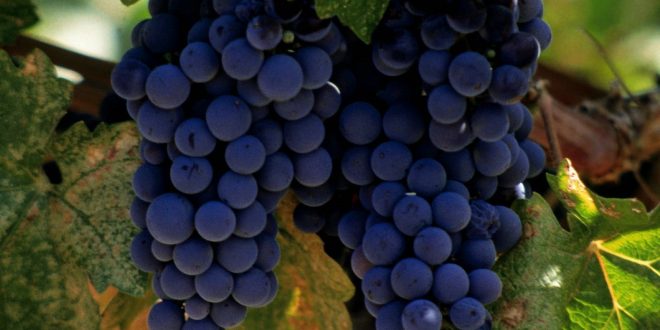

In general, the autumn treatment can be divided into preventive and therapeutic.
Preventive
Carried out in late autumn, after pruning and before sheltering the bushes for the winter. For this, a 3% solution of copper sulfate or Bordeaux liquid is used. These drugs are the most harmless among chemicals and are excellent at helping to prevent the appearance of fungal diseases. From rodents (mice, hares), which can damage wood, roots and lashes of grape bushes, chemical preparations such as "Storm" or "Blockade" are used. Spraying with such preparations as "Aktellik", "Fozalin", "Akarin", "Neoron" helps well against insect pests.
Therapeutic
If the slightest signs of disease or the presence of insect pests are detected, it is necessary to spray for medicinal purposes. To do this, you do not need to wait for autumn, but act immediately after harvesting and use quick-acting preparations. First, it is necessary to remove the affected leaves, branches and burn, and treat the cuts with garden varnish.
Often in such cases, copper sulfate or Bordeaux liquid is used. They work well against fungal and bacterial diseases, and also help get rid of moss and lichens. A good result is given by spraying with fungicides against specific diseases. So, drugs "Folpan", "Delan", "Amistar" are used against mildew. Against oidium - Impact, Mikal, Fundazol. "Horus", "Rock" fights well with gray rot. Rovikurt and Polykhom are used against pests.
Very often, an unusually spectacular weaving plant is used to decorate hedges, terraces and gazebos - girlish grapes. In autumn, this decorative culture looks unusually impressive. The bright red leaves of some varieties can be just a chic decoration of the site.
Of course, girlish grapes in the fall, like ordinary grapes, need some care. The plant is frost-hardy, and therefore it does not need to be sheltered. However, prevention against various kinds of viral and fungal diseases is worth it. Since ordinary and girlish grapes belong to the same family (and, therefore, they have the same diseases), in the fall this decorative culture can also be sprayed with a solution of copper sulfate. This will prevent the development of all sorts of pathogenic fungi and viral infections.
So, now you know how to process grapes in the fall. Plant pests can be eliminated by spraying with a solution of copper sulfate. Top dressing is done by treating the plants with potash fertilizers diluted with water. In any case, with proper autumn preparation, the grapes will overwinter well and will probably give a good harvest next year.
How to spray grapes in front of shelter for the winter
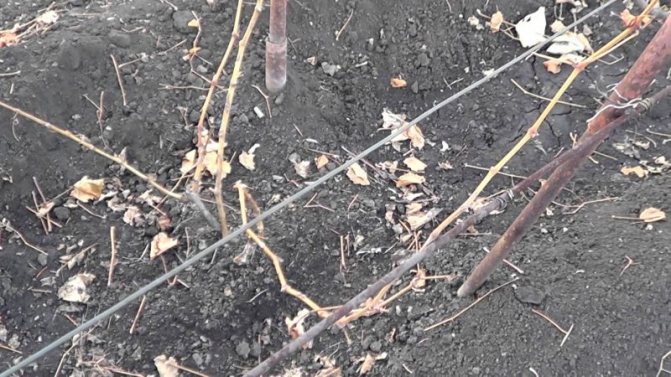

Autumn spraying is a mandatory measure to protect the crop and stimulate its fruiting in the next season. At this time, the use of aggressive agents is allowed, which are aimed specifically at destroying diseases and pests, and not at curbing their development.
Application of chemical compositions
Most modern insecticides that successfully perform their pest control functions are used in the spring and fall. They are subdivided into contact and systemic drugs. The chemical action of the former is based on the direct destruction of insects and their offspring.
Examples of popular drugs:
- Akari;
- "Avant";
- "Confix";
- "Travertine".
The problem is that often, after using them, pests develop resistance to the chemical. In this case, systemic insecticides help, since they penetrate into the deep tissues of plants and will not allow insects that woke up in spring to feed.
Well proven:
- Aktara;
- "Commander";
- "Calypso";
- Biotlit.
Acaricides are used to combat all types of ticks.
Examples:
- Antelik;
- "Neuron";
- "Freemason";
- "Steam".
Pests often hide in the soil, in the cracks in the bark of the vine, in the root soil.
Fungicides are used to combat fungal and viral diseases. Contact-protective preparations are suitable for autumn spraying:
- Fundazol;
- "Euparen";
- "Dnok";
- "Cupritox";
- "Strobe";
- Bayleton;
- "Nitrafen".
Ridomil Gold and Topaz are formulations with a powerful therapeutic and prophylactic mechanism. They are mainly used for autumn processing, as they can accumulate in berries.
The use of folk remedies
Many popular methods of protection are not inferior to industrial drugs - the effect of such remedies has been tested and confirmed by years of practice.
Copper sulfate
Copper sulfate is one of the least toxic drugs. Destroys disease-causing strains, disinfects the plant for a long time. The solution is made in warm water, in a ratio of 1:50. The composition is good for 5 hours, then it loses its beneficial properties and changes its structure.
Processing is carried out after leaf fall, in two stages with an interval of three weeks, before the onset of frost. The bushes and soil around are sprayed completely. Copper sulfate forms a breathable film on the shoots, which additionally helps to keep warm.
Bordeaux liquid
Bordeaux liquid is especially effective against black rot, anthracnose and a number of other fungi. The finished composition is sold in garden stores, but you can prepare it yourself. The maximum safe concentration for grapes is 3%.
For the solution you will need:
- 10 liters of water;
- 450 g quicklime;
- 300 g of copper sulfate.
In a non-metallic container, vitriol and lime are diluted separately in 1 liter of boiling water. Both liquids are filtered and poured into a common container, stirring constantly until smooth. The concentrated solution is added to the rest of the water.
One bush takes about 1 liter of ready-made liquid.
Urea
A universal agent for feeding and protecting is urea. It prevents the spread of scab, aphids, copperheads, weevils.
Take 500-700 g of urea on a bucket of water and dissolve thoroughly without sediment. The bushes are sprayed 1-1.5 months before the first frost.
Soda with potassium permanganate
Solutions of soda and potassium permanganate fight powdery mildew, gray mold, powdery mildew, eliminates caterpillars. Additionally, they act as growth stimulants, rejuvenate the grape bush, and improve the taste of berries.
For a solution of potassium permanganate, take 1 g of potassium permanganate per 200 ml of water. If you add boric acid, you get an excellent root feeding with microelements.
Soda antifungal solution is prepared from:
- 1 tbsp. l. baking soda;
- 1 tbsp. l. any vegetable oil;
- 100-200 ml of liquid detergent.
All components are mixed in 10 liters of water. The composition is harmless and applicable at any time of the year.
Autumn processing of grapes with copper sulfate
To make a one percent solution of copper sulfate, you need to dilute 100 grams in 10 liters of water. of this substance. If you need 4% - respectively 400 gr. Do not pour the powder into the bucket right away. First, pour warm water into a half liter jar. Pour the vitriol there and stir well. Pour the resulting solution into a bucket. Stir constantly and add water until it is full.
So, we have found out what should be done to treat grapes in the fall from diseases. Now let's see how it should be done correctly. Copper sulfate, as already mentioned, is a poisonous substance and very harmful to the human body. Therefore, it is possible to spray plants with it only by taking some personal safety measures. Wear rubber gloves and spray only in the direction of the wind.
Plants can also suffer as a result of improper processing. To prevent burns on the branches, spraying should be carried out in cool weather.Sometimes in the fall during the day the air warms up to rather high temperatures. In this case, the treatment should be done in the morning or in the evening, or wait a few days until the temperature drops.
In preventive treatments of grapes, it is important not to confuse the timing of spraying with iron and copper sulfate.
Iron vitriol is not suitable for spring treatments, since it inhibits the opening of eyes. Therefore, in March-May, preference is given to copper sulfate.
But for the autumn treatments of the grapevine, iron sulfate is perfect.
Please note that it is possible to carry out combined treatments of grapes, that is, spray the vine with several drugs at once for various diseases at the same time. This "cocktail" is called a tank mix.
To prepare the correct tank mixture, the recommended dose of each drug is first diluted in a small amount of water, then added to the general container. In this case, different drugs must be dissolved in different containers.
The amount of water is not cumulative! For example, if, according to the instructions, each of the drugs must be diluted in 10 liters of water, then the total volume of water in the tank mixture should be 10 liters. That is, if you previously diluted 2 drugs in 2 liters of water, you need to pour the resulting solutions into 8 liters of water, so that in the end the volume of the entire tank mixture is equal to the declared 10 liters.
We also recommend that you keep a visual Grape Care Calendar, which will help you not to miss the timing of fertilizing, pruning and processing.
Traditionally, grapes are processed with copper sulfate in autumn and spring. After winter, when the nursery wakes up from hibernation, the drug helps to disinfect bushes and kill pests and pathogens lurking in the bark. In the spring, the primary treatment is done in March, while the pests are inactive.
The second time the grapes are sprayed closer to winter. The reason is the same - the destruction of disease-causing strains and the prevention of new diseases. Thanks to the protective measure, the grapes will be strong in the spring. But vitriol must be used carefully, since its composition is dangerous for young vines with burns. The substance is not used in its pure form. It is diluted with water and obtained Bordeaux liquid.
Spraying rules
- Any spraying is carried out in dry, calm weather, in the evening.
- The bushes should not have any usable bunches left.
- The solution should cover the plant with a thin layer on all sides.
- Chemicals are diluted in the dosage indicated by the instructions.
- It is advisable to fix the result with a repeated procedure in a week.
When working with chemicals, a prerequisite is the use of rubber gloves, a mask or respirator. This will protect the skin and respiratory system from burns and intoxication.
What's next
Pruning and spraying are important points for preparation, but this is not the end of it, such agronomic measures only protect against disease. Now let's move on to the next steps so that the grape bush can feel more protected against the winter cold and chill. Let's move on to step-by-step instructions:
- If the autumn period is not characterized by high humidity, then the shrub should be watered abundantly.
- Conduct top dressing. Better to do this in September. Use potash or potassium phosphate fertilizers.
- Remove the unripe vine (it is usually green), as it will freeze in winter.
- Preparing the soil. It is necessary to make a trench in order to lay the vine in it. Not all varieties require this.
- We cover with pre-prepared material, which must be additionally neutralized.
Read more: Duck dietary meat or not - Indo-duck benefits and harms
What can be used to cover grapes? Spunbond, burlap, and cotton thick fabric will do. After wintering, they will need to be dried.The use of wooden flooring, roofing felt and straw also requires treatment with copper sulfate or another substance that you have chosen for treating the shrub.
Regardless of the experience of viticulture, it is better to adhere to all of the above instructions and recommendations. Because how much you were able to cover and provide wintering for your grape bush, its further growth and yield will depend.
Caring for grapes after harvest
Depending on the variety, from the beginning of August, the grower can safely harvest. The early varieties are harvested with juices earlier, and the latest ones allow the berries to be harvested at the end of September. As soon as the vine is freed from bulky and heavy bunches, the winegrower will have to move on to the next stage of vineyard maintenance. Autumn plant preparation includes the following processes:
- pruning vines and shoots;
- treatment of the entire vineyard with special solutions from pests;
- rhizome protection (shelter before winter).
If the grapes are properly protected before winter and during the first cold weather, the bushes will last more than one year, bringing a stable harvest every year. Processing with special means requires special skills, therefore, at first, it is recommended to involve specialists or consult with experienced winegrowers. Experienced gardeners make their own processing tools. In such solutions, a person can be 100% sure. It will be difficult to process the vine and root system the first time. A beginner can watch a video on the Internet or consult with professional winegrowers.

